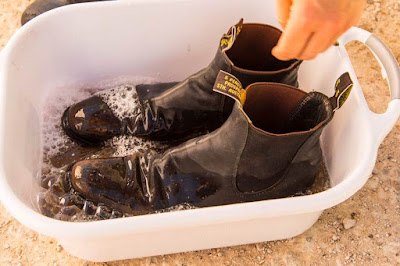 Vines dying as phylloxera spreads in Victoria's Goulbun Valley
Vines dying as phylloxera spreads in Victoria's Goulbun ValleyVinehealth police losing to phylloxera
by PHILIP WHITE
Australia's main viticulture council, the struggling Vinehealth Australia, is losing its battle against Phylloxera.
Phylloxera is the dreaded root louse which killed well over two-thirds of the vineyards of Europe, principally France, in a few fast decades in the late 1800s.
Rife in Victoria's Yarra Valley, the northern side of the Victorian Alps and the flat country around Geelong where Neuchâtel Swiss colonists introduced it in the earliest days of the white invasion, the deadly bug continues to spread.
Vinehealth Australia this morning announced the seventh extension to the Maroondah Phylloxera zone in the Yarra Valley.
The killer bug was first found in this area in 2006.
The quarantine zone now spreads from Castella in the north to Warrandyte in the suburban south-west, from Panton Hill in the west to Healesville in the east.
From the weird bug family Phylloxeridae, from the order Hemiptera, this incurable scourge is variously known as Daktulosphaira vitifoliae, Phylloxera vastatrix, Daktulosphaira vitifoliae and Phylloxera vitifoliae.
There is no way of removing the bug from infected ground. If owners of dead vineyards want to continue in the business, they must plant vinifera grape varieties grafted to non-bearing glory vine rootstock from North America.
This changes the nature of the vine dramatically.
The flavours change forever.
While South Australia has not yet discovered a phylloxera incursion, its great international wealth in vineyards lies in its old pre-phylloxera vines which still grow on their own roots, like they no longer do anywhere on Earth. It seems likely the world's oldest Shiraz, Grenache, Cabernet and Riesling vines still growing viable crops are all in South Australia. These will be lost should the bug cross the border.
completely vulnerable: productive 1843 Shiraz in the Lindner family's Langmeil Wines' Freedom Vineyard at Tanunda in South Australia's Barossa Valley
There was much contention in 2012 when the old Phylloxera Board, which had done a brilliant job beforehand, was convinced by big vine nurserymen and the biggest winemakers to relax quarantine measures.
As vendors of grafted rootstock, or owners of vineyards already grafted, these people stood to make many millions should phylloxera cross the border.
The replacement organisation, Vinehealth Australia, seems transfixed in its management of another new killer bug known as Pinot gris disease.
Little is understood about this new arrival. It's butchering vineyards of all varieties right around the world.
"Measures have been taken to ensure that no spread will occur from the vines in which the virus has been detected in Australia," Vinehealth said in a press release.
"To determine the extent of GPGV in Australia, targeted surveillance for the virus by relevant state government biosecurity departments will take place this spring when symptoms are most evident."
In today's phylloxera advice, Vinehealth Australia CEO Inca Pearce said "A lack of available chemical or biological control for phylloxera means there is no treatment for a phylloxera-infested vineyard. The only option is to pull out the vineyard and replant with new vines that have been grafted onto phylloxera tolerant or resistant rootstock. Pulling out vines and replanting comes at an approximate cost of $60,000 per hectare, including vine removal, new grafted vine material and new block infrastructure, notwithstanding loss of production while new plantings mature.
“We know phylloxera doesn’t respect state borders. It’s time for vineyard owners to get serious about farm-gate hygiene to prevent an incursion of phylloxera.”
Farm gate? I have driven from one end to the other of the phylloxera-infested King Valley twice in the last five years. Keen to observe the protocol advice there for travellers, I was shocked to find none.
Not one sign mentioned it.
You cannot trust growers to police this scourge at their farm gates. This evil needs to be policed by a bunch of heavily-armed and armoured Border Patrol savages in very scary uniforms.
Viable phylloxera has been found in the sumps of Melbourne carwashes and in windsocks towed by aircraft at 30,000' over Europe.
I cannot believe viable phylloxera wasn't washing down the Yarra through Melbourne in last year's floods.
To read the prescribed protocol click here.


















4 comments:
i agree about the armored heavies whitey ... anybody can walk into a vineyard anywhere
A mate of mine flew directly from NSW to Turkey Flat in the Barossa and was invited (at his request) to tour the oldest of old vines in the vineyard. No boot washing, no questions, nothing. We're doomed.
never let the truth get in the way of a good story Whitey once again lack fact and stretch the truth.
Hear hear! You're a wanker whiteman. Eutypa/Dieback/Deadarm is a much great threat than phylloxera, which as you well know is contained and policed.
Post a Comment